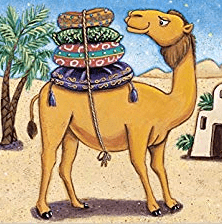How the Camel Got His Hump | English (It so Happened) Class 8 PDF Download
INTRODUCTION
Here is a story which underlines the message that work is the key to sound health and happiness. Those who have nothing much to do, grow humps on their back. Their curve in their spine deforms the body. This rule applies to children as well as grown – ups. The camel, says the story has got a hump on its back. It is because in very early times be used to escape work. He lived in the desert doing nothing while the horse, the dog and the ox had to work double time. The three animals first complained of it to their master man but he took no action. Then they complained of it to the Djinn of the desert. The camel got the hump as a punishment. 
INTRODUCTORY QUESTIONS
Ques 1: What sort of animal is camel?
Ans: There are two chief kinds of camels.
- The Arabian camel, also called dromedary, which has one hump
- The Bactrian camel, which has 2 humps.
Ques 2: what is hump?
Ans: The hump is a large lump of fat that provides energy if food is hard to find.
Ques 3: what do you think the story is going to be about?
Ans: About the camel and its hump.
WORD MEANING
| Word | Meaning |
| 1. Djinn | A spirit with strange powers |
2. In the beginning | At the start |
3. Howling | long loud cry |
| 4. Prickles | Thorns |
| 5. Saddle | Seat on horse’s back |
6. Trot | Move at medium pace |
7. Fetch | Go and bring |
8. Yoke | Wooden bar put across the neck of animals |
| 9. Sorry for you | Feel sad about you |
| 10. Chewing the cub | Move jaws and teeth to grind food |
| 11. Idle | one who does not work |
| 12. Remonstrated | Argued with |
13. Dust cloak | loose outer garment of dust |
| 14. Reflection | Image |
| 15. Puffing up | Rising, swelling |
| 16. Hump | Lump on the back |
NEW WORDS
Whishing
Presently
Rolled
Remonstrated
Reflection
Saddle
Prickles
VERY SHORT QUESTION ANSWER
Ques 1: what tasks, do you think, were assigned to the dog and the ox?
Ans: The dog was assigned the task of fetching and carrying. The ox was made to plough the fields.
Ques 2: why did the camel live in the middle of the desert?
Ans: The camel lived in the middle of the desert because it didn’t want to work.
Ques 3: The camel said, ''Humph'' repeatedly. How did it affect him?
Ans: The word 'Humph' annoyed the Djinn. He turned 'humph' into the hump on the camels back.
Ques 4: "... he has never yet learnt to behave." In the light of this, what is the writer's opinion about the camel?
Ans: The writer is of the opinion that the camel has not changed its nature and habits to this day.
Ques 5: Can this story be factually true?
Ans: No, the story is not factually true. It is just an imaginary one.
Ques 6: There are broadly two categories of workers- those who prefer to do today what they can do tomorrow, and those who prefer to do tomorrow, what they can do today. Where do you belong?
Ans: I generally want to do today what I can do tomorrow. I don’t like to put off till tomorrow what I can do today.
|
12 videos|73 docs|8 tests
|
FAQs on How the Camel Got His Hump - English (It so Happened) Class 8
| 1. What is the story behind "How the Camel Got His Hump"? |  |
| 2. What is the moral lesson of the story "How the Camel Got His Hump"? |  |
| 3. Is "How the Camel Got His Hump" a true story? |  |
| 4. What age group is "How the Camel Got His Hump" suitable for? |  |
| 5. What is the significance of the hump on a camel's body? |  |

















